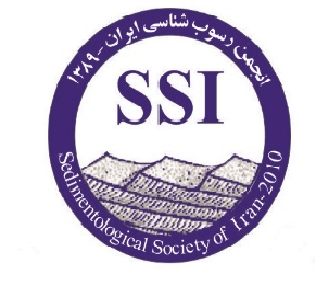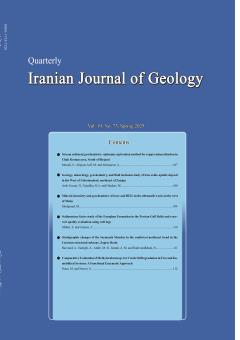Stratigraphic changes of the Seymareh Member in the southwest-northeast trend in the Lurestan structural subzone, Zagros Basin
Subject Areas :Ayoub Bazvand 1 , Mahmoud Jalali 2 * , Mohammad Hossein Adabi 3 , A.M. Jamali 4 , N. Hadavandkhani 5
1 - Ph.D student of Shahid Beheshti University
2 -
3 -
4 -
5 -
Keywords: Lopha Limestone, Gurpi Formation, Sultan Anticline, Lithostratigraphy,
Abstract :
In order to study and compare the stratigraphy of the Seymareh Member (Lopha Limestone Member) in a southwest-northeast trend in the Lurestan subzone, three stratigraphic sections of the Gurpi Formation containing the Seymareh Member, including the Sheikh-Makan section (Kabir-kuh Anticline), the Bagh-Gol section (Sultan Anticline), and the Siah-Darreh section (Zangul Anticline), were studied and then compared with other studied sections along the trend. The Seymareh Limestone has the greatest thickness in the southwestern areas of the Lurestan, so that in the studied sections, its maximum thickness is 43 meters and belongs to the Kabir-kuh Anticline, and then it gradually decreases in thickness towards the northeastern areas so that some of its rock units are no longer visible. This reduction in thickness reaches 8 meters in the Sultan Anticline, then less than 1 meter in the Zangul Anticline, and finally disappears. The decrease in the thickness of the Seymareh Member towards the northeast of the Lurestan is influenced by the tectonic movements of the Zagros foreland Basin, so that gradually towards the northeast of the Lurestan, with increasing depth, the sedimentation of this shallow member has decreased. The age of the Seymareh Member, based on the biozones identified at its lower and upper boundaris, is Middle Campanian in all three stratigraphic sections studied.
بازوند، ا.، صادقی، ع.، آدابی، م. ح.، جمالی، ا. م. و هداوند خانی، ن.، 1404. زیستچینهنگاری سازند گورپی بر مبنای روزنبران پلانکتونی در برش شیخمکان (تاقدیس کبیرکوه، ناحیه لرستان)، فصلنامه علمی علوم زمین, 35(1)، 18-1. doi: 10.22071/gsj.2024.457598.2141
بازوند، ا.، صادقی، ع.، آدابی، م. ح.، جمالی، ا. م. و هداوند خانی، ن.، 1403. زیست چینهنگاری و بررسی تغییرات عمق دیرینه نهشتههای سازند گورپی بر مبنای فرامینیفرهای پلانکتونی در برش باغگل، ناحیه لرستان، حوضه زاگرس، فصلنامه زمینشناسی ایران، 70 (18)، 96-79.
بلمکی، ب.، اصغریانرستمی، م. وحیدینیا، م. و محمدی، م.، 1389. مطالعه جغرافیای دیرینه عضو سیمره، سازندگورپی، بر مبنای مطالعه سیستماتیک خارپوستان و روزنداران در برش میش-خاص، جنوب شرق استان ایلام، نشریه رخسارههای رسوبی، 3(2)، 30-19.
قورچايي، ش.، 1385. بيواستراتيگرافي سازند گورپي در شمال كبيركوه بر مبناي فرامينيفرا؛ پایاننامهی كارشناسي ارشد، دانشگاه تهران، 167 .
مغفوری مقدم، ا.، 1394. ریز زیست چینهنگاری سازند گورپی در یال جنوب باختری تاقدیس خرمآباد، حوضه زاگرس، یافتههای نوین زمینشناسی کاربردی، 9(18)، 38-32.
همتینسب، م.، 1387. ميكروبايواستراتيگرافي و چينهنگاري سكانسي سازند گورپي در برش كاور، جنوب كبيركوه، پاياننامه كارشناسي ارشد، دانشگاه تهران، 175 .
Bolli, H.M., Saunders, J.B. and Perch-Nielsen, K. eds., 1989. Plankton stratigraphy: volume 1, planktic foraminifera, calcareous nannofossils and calpionellids (Vol. 1). CUP Archive.
Darabi, G., Maghfouri-Moghaddam, I., Sadeghi, A. and Yusefi, B., 2018. Planktonic foraminifera and sea-level changes in the upper Cretaceous of the Gurpi Formation, Lorestan basin, SW Iran. Journal of African Earth Sciences, 138, 201-218. DOI: 10.1016/j.jafrearsci.2017.11.011
DeCelles, P.G. and Giles, K.A., 1996. Foreland basin systems. Basin research, 8(2), 105-123.
Hashmie, A., Rashwan, M., El Hedeny, M., Sharyari, S., Rahimi, S. and Mansour, H., 2020. Facies development, palaeoecology, and palaeoenvironment of the Seymareh (Lopha Limestone) Member of the Gurpi Formation (Upper Campanian), Lurestan Province, SW Iran. Geological Journal, 55(10), 1-14.
Heydari E., 2008. Tectonics versus eustatic control on supersequences of the Zagros Mountains of Iran. Tectonophysics, 451(1-4), 56-70. https://doi.org/10.1016/j.tecto.2007, 11.046
Homke, s., Verges, J., Serra-Kiel, J., Bernaola, G., Sharp, I., Garcés, M., Montero-Verdú, I., Karpuz, R. and Goodarzi, M-H., 2009. Late Cretaceous–Paleocene formation of the proto–Zagros foreland basin, Lurestan Province, SW Iran, GSA Bulletin, 121(7/8), 963–978. doi:10.1130/B26035.1
James, G. A. and Wynd, J. G., 1965. stratigraphy nomenclature of the Iranian, oil consortium agreement area, Report No.1027.
Kamyabi Shadan, H., Dashtban, H., Roshandel Arbatani, B. and Foroghi, F., 2019. Late Cretaceous Echinoids from the Seymareh member (Lopha Limestone member), KabirKuh Anticline, Southwest of Iran. Geopersia, 9(2), 305-350.
Kroh, A. and Smith, A.B., 2010. Classification and phylogeny of post–Palaeozoic echinoids. Journal of Systematic Palaeontology, 7, 147–212.
Loeblich, A. R. and Tappan, H., 1988. Foraminifera Genera and their Classification,Van Nostrand Reinhold, New York, 970.
Smith, A.B.and Wright, C.W., 2003. British Cretaceous echinoids. Part 7, Atelostomata, 1. Holasteroida: 440– 568, 139. 182, The Palaeontographical Society Monographs, London.
Stöcklin, J., 1968. Structural history and tectonics of Iran: a review. AAPG bull. 52(7), 1229-1258.
Stocklin, J. and Setudehnia, A., 1991. Stratigraphic Lexicon of Iran; Geological Survey of Iran, Tehran, 18, 409.
Olsson, R. K., Berggren, W. A., Hemleben, C. and Huber, B. T. 1999. Atlas of Paleocene planktonic foraminifera, Smithsonian institutionpress, Washington, 252.
Postuma, J. A., 1971. Manual of planktonic foraminifera, Amsterdam, London, Elsevier.
Premoli Silva, I. and Verga, D., 2004. Practical Manual of Cretaceous Planktonic Foraminifera, Course 3. In: Verga, D., Rettroi, R. (Eds.), International school of Planktonic Foraminifera. Universities of Perugia and Milano. Tripografiadi di Pontefecino, Perugia, 283.
Razmjooei, M.J., Shahryari, S., Kani, A., Ullmann, C.V., Jamali, A.M., Rahimi, S., Verges, J. and Thibault, N., 2021. Integrated bio-and carbon isotope stratigraphy of the Campanian–Danian sedimentary succession in Lurestan (Zagros Basin, Iran): Implications for syntectonic facies distribution and basin evolution. Journal of Asian Earth Sciences, 214, 104779.
Saura, E., Vergés, J., Homke, S., Blanc, E., Serra-Kiel, J., Bernaola, G., Casciello, E., Fernández, N., Casini, G., Embry, J.C. and Sharp, I.R., 2011. Basin architecture and growth folding of the NW Zagros early foreland basin during the Late Cretaceous and early Tertiary. Journal of the Geological Society, 168(1), 235-250. doi: 10.1144/0016-76492010-092.
Van Buchem, F.V., Gaumet, F., V!edrenne, V. and Vincent, B., 2006. Middel East Cretaceous sequence stratigraphy study. Part 1-S.W.Iran. Final report, Institut Français du petrol in cooperation with the National Iranian Oil Company-Exploration Directorate.

